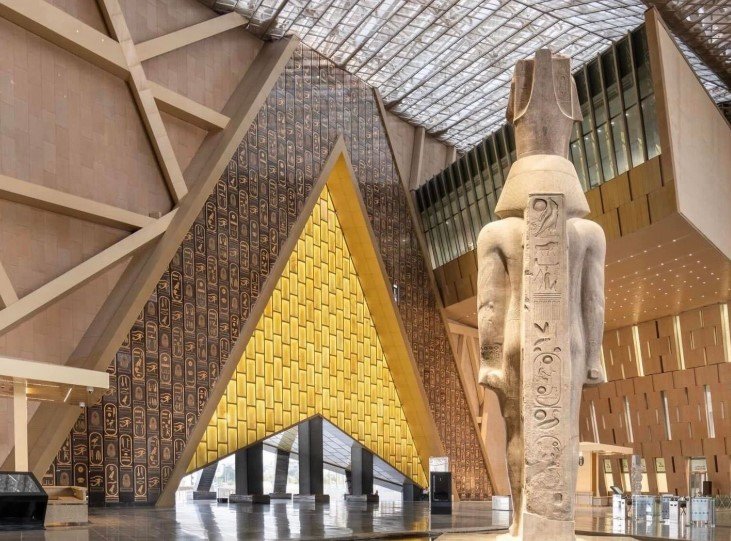After more than two decades of planning and construction, the Grand Egyptian Museum in Cairo welcomed its first full wave of visitors on November 1, 2025. This massive cultural landmark, located near the iconic Giza pyramids, now showcases over 100,000 ancient artifacts, including the complete collection from King Tutankhamun’s tomb for the first time ever.
A Long-Awaited Milestone in Egyptian History
The journey to open the Grand Egyptian Museum started back in 1992, when plans were first announced to create the world’s largest museum dedicated to a single civilization. Construction kicked off in 2005, but faced numerous delays due to political changes, funding issues, and the global pandemic.
Over the years, the project grew into a billion-dollar endeavor, blending modern architecture with ancient wonders. Partial openings began in October 2024, allowing limited access to some galleries. The full unveiling on November 1 marked a historic moment, celebrated with fireworks and an inauguration ceremony attended by global leaders and Egyptologists.
This opening comes at a key time for Egypt, as the country aims to boost tourism amid economic challenges. Experts say the museum could draw millions of visitors annually, putting Cairo back on the map as a top cultural destination.
Stunning Highlights and Must-See Artifacts
At the heart of the museum is the Tutankhamun gallery, spanning 80,000 square feet and displaying all 5,398 items from the young pharaoh’s tomb. Discovered by Howard Carter in 1922, these treasures include golden masks, chariots, thrones, and coffins that have never been shown together before.

Visitors can climb the grand staircase, lined with statues from various dynasties, leading to panoramic views of the Giza pyramids. Another standout is the massive atrium featuring an 11-meter-tall statue of Ramses II, weighing over 83 tons.
The museum also houses Khufu’s solar boat, a 4,600-year-old vessel, and interactive exhibits that bring ancient Egypt to life. With artifacts from the Predynastic period to Coptic times, it offers a comprehensive look at Egypt’s rich past.
Here are some key artifacts making their debut:
- The complete set of Tutankhamun’s canopic jars, used to store organs during mummification.
- Elaborate jewelry and amulets from the tomb, showcasing intricate goldwork and precious stones.
- Restored chariots that highlight ancient Egyptian engineering and warfare.
Architecture and Design That Blend Old and New
Designed by Irish firm Heneghan Peng Architects, the museum covers nearly a million square feet and uses cutting-edge technology for preservation and display. Its sloped roof and stone facade echo the nearby pyramids, creating a seamless link between past and present.
Inside, natural light floods the spaces, enhancing the viewing experience. The layout guides visitors through chronological exhibits, making it easy to follow Egypt’s timeline.
Sustainability plays a big role too, with energy-efficient systems and green spaces around the site. This modern approach ensures the artifacts are protected for future generations while providing an immersive environment.
The museum’s location, just two kilometers from the pyramids, adds to its appeal. Planners designed it to handle up to 20,000 visitors daily, with wide halls and advanced crowd management.
Impact on Tourism and the Economy
Egypt’s tourism sector, hit hard by recent global events, sees the museum as a game-changer. Officials predict it will attract five million visitors in its first year, generating significant revenue for local businesses.
The opening aligns with other efforts to revive interest in Egyptian heritage, such as improved infrastructure around Giza and new archaeological discoveries. It also sparks renewed calls for the return of artifacts held in foreign museums, like the Rosetta Stone in London.
To understand the potential economic boost, consider this table of projected impacts:
| Aspect | Details | Estimated Impact |
|---|---|---|
| Visitor Numbers | Up to 20,000 per day | 5 million in first year |
| Revenue Generation | Ticket sales and merchandise | $500 million annually |
| Job Creation | Museum staff and tourism roles | Over 10,000 new positions |
| Global Attention | Media coverage and partnerships | Increased international tourism by 15% |
These figures highlight how the museum could transform Cairo into a hub for cultural travel.
Visitor Tips and What to Expect
Planning a trip? Tickets start at around $30 for adults, with options for guided tours and special exhibits. The museum operates from 9 a.m. to 5 p.m. daily, but check for extended hours during peak seasons.
Arrive early to beat the crowds, and wear comfortable shoes for the vast space. Audio guides in multiple languages enhance the experience, and there’s a children’s museum with hands-on activities.
For those traveling from abroad, Cairo International Airport is about 45 minutes away by car. Public transport links are improving, making access easier.
As Egypt celebrates this achievement, the museum stands as a bridge between ancient glory and modern ambition. Share your thoughts on this epic opening in the comments below, and spread the word to fellow history buffs.
